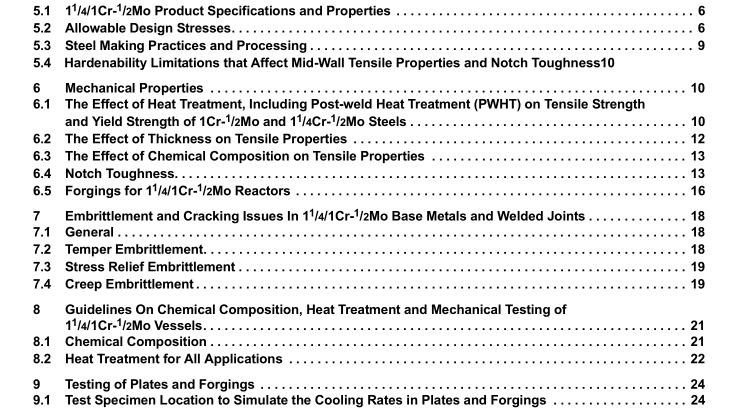API TR 934-D:2010 pdf free download.Technical Report on the Materials and Fabrication Issues of 1 1 / 4 Cr- 1 / 2 Mo and 1Cr- 1 / 2 Mo Steel Pressure Vessels
4.2 Past In-Service
Cracking and Toughness Problems with 1 1 / 4 /1Cr- 1 / 2 Mo Steels In-service cracking problems have been noted for 1 1 / 4 /1Cr- 1 / 2 Mo steel equipment including pressure vessels and piping. [1] These problems were experienced in both the refining and electric power industries and were related to weld cracks. Nearly all cracking was in reactors and piping, listed in Table 2 and Table 3.
Whereas most problems in the refining industry were related to pressure vessels, the electric power industry experienced cracking in longitudinal weld seams of high temperature steam lines, which operated primarily at or above approximately 850 °F (454 °C).
Most notable in the refining industry was creep related cracking of Catalytic Reformer reactors. This was reported in Japan, [2] and led to other studies in the United States. [3][4] It was categorized as creep embrittlement (a term that will be discussed later on). Several papers were published that described this cracking and other property changes. Table 4 lists the previous literature, experience, and data that describe these issues.
In December 1986 there was an MPC workshop on “Embrittlement of Low Alloy Steels During Exposure at Elevated Temperature Service”. Shortly afterwards API/MPC surveyed refineries worldwide on these cracking problems. [5] More than 70 incidents were reported from 25 companies. In all cases where deep cracks were found and major repairs required, the reactors were replaced within a few years. In the majority of cases, crack initiation was at major nozzle to reactor welds.
Cracking was predominantly in heat affected zones (HAZ) and was intergranular. Creep fissuring was also found. Initially the term “creep embrittlement” was used to describe this phenomenon. In some cases where CVN toughness measurements could be made low toughness values were also reported. Low toughness values in the range of 5 ft-lb to 10 ft-lb (at room temperature) were reported for both plate material and forgings. [3] It was difficult to improve the toughness with a postweld heat treatment (PWHT).
In most cases normalizing was required to assure a return of toughness. [4] It was assumed at the time that the low toughness was related to long term exposure at operating temperatures above 1000 °F (538 °C), [3] but it is also possible that these steels had low toughness at the start. If so, the terms “irreversible embrittlement,” or “stress relief embrittlement” may be applicable to this effect. Considering that the ASME toughness requirements (Figure UCS-66, Section VIII, Div. 1) were only established in 1987, well after these vessels were fabricated, these vessels may not have had Charpy V- notch (CVN) toughness testing requirements and, therefore, may have had low toughness values from the beginning. These steels may also have been produced to coarse grain practice. Another interesting observation related to CVN test results was that several test samples exhibited high impact energy values but failed in a cleavage mode. Appropriately, the term “high energy cleavage” was applied. [3] This result encouraged the use of percent shear and lateral expansion measurements in qualifying these steels in future construction.
5 General Considerations
5.1 1 1 / 4 /1Cr- 1 / 2 Mo Product Specifications and Properties The 1 1 / 4 /1Cr- 1 / 2 Mo products are available to the specifications, grades, and classes shown in Table 5a. When using different product forms, (e.g. plates and forgings) in the same vessel or assembly, grades and classes of material with the same nominal chemical composition should be used so that the same PWHT temperatures and hold times can be used for the vessel or welded assembly. The same basic 1 1 / 4 /1Cr- 1 / 2 Mo steel compositions are also covered in a European specification EN 10028-2: 2003 as Grades 13CrMo4-5 and 13CrMoSi5-5. The European specification covers two categories, normalized and tempered, and quench and tempered, as shown in Table 5b. It also shows that the thicker plates need to be quenched and tempered.API TR 934-D pdf download.API TR 934-D:2010 pdf free download
